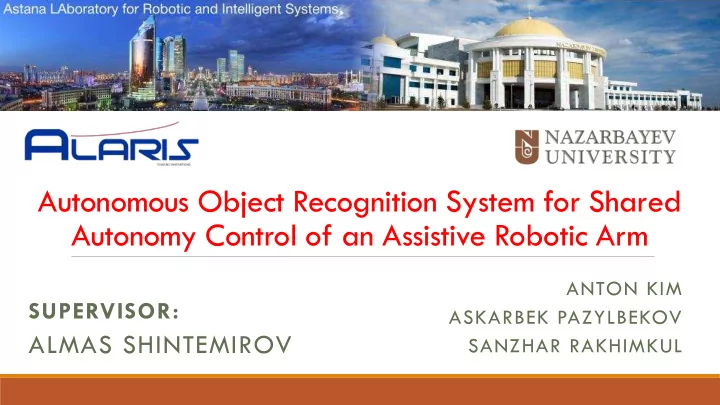

Autonomous Object Recognition System for Shared Autonomy Control of an Assistive Robotic Arm ANTON KIM SUPERVISOR: ASKARBEK PAZYLBEKOV ALMAS SHINTEMIROV SANZHAR RAKHIMKUL
Outline Introduction, Conclusion and Future work Problem Statement Background research, Object Recognition and Methodology Autonomous grasping Manual Control mode
1 billion people have special needs (WHO) 300 million people possess severe disabilities More old people more people with special needs Source: World Report on Disability, World Health Organization (2011) Photo credits: https://www.pexels.com
4.6% of men and 3 .4% of women are suffering from disabilities Figure 1. United Nation Disability Statistics (2018) for Kazakhstan Source: UN Disability statistics
Solution - autonomous assistive robots 6 DOF Weight: 5.2 kg Payload: 1.6 kg Wrist angle: 60° Power consumption: 25W Available at NU facilities Fig 2. Kinova Jaco 2 Assistive Robotic Arm Source and Photo credits: Kinova’s official website
Background Research. Joystick Control • Intuitive adaptive orientation control proposed by Vu et al. (2017) • “…the default control of the end- effector (hand) orientation has been reported as not intuitive and difficult to understand and thus, poorly suited for human-robot interaction” • Proposed control algorithm is not suitable since ordinary gamepad is used Fig 3. Control map proposed by Vu et al.
Background Research. Object Detection • SNIPER – state-of-art 2D object detection system, however, is very slow (Singh et al. (2018)) • DOPE – state-of-art 3D object detection model (Tremblay et al. (2018)), small dataset • YOLOv3 – most popular object detection algorithm proposed by Redmon et al. (2018) • CornerNet – model faster than YOLO, proposed by Law et al. (April 18, 2019) • CenterNet – model, faster and more accurate than YOLO proposed by Zhou et al. (April 25, 2019)
Methodology of Shared Autonomy Control for Robotic Arm Methodology of Shared Autonomy Control for Robotic Arm Graduation Project Manual Mode Spherical Coordinates control by joystick Megatron Joystick Automatic Mode Object Grasping Object recognition and v autonomous movement (Bottle) towards the object Semi-automatic Mode Intel RealSense D435 Human Intention RGB-D sensor prediction based on HMM
Overall Project Setup RGB-D is static Current Setup Previous Setup #2 Previous Setup #1
Manual Control - Overview Mode 1: moving the end-effector in the space Mode 2: keeping the position of the end- effector, rotating it about a point Mode 3: end- effector’s fingers are controlled Modes are switched through the buttons Spatial constraints are set to avoid hitting objects nearby (Computer, walls, etc) TRY100 Megatron 3-axis joystick with two buttons
Manual Control – making more intuitive Control based on Cartesian coordinates (Default) Control based on Spherical Coordinates (Proposed) COUNTER-INTUITIVE INTUITIVE
Control Flowchart of Autonomous Control Mode Implementation Reference position of several target objects Intel YOLO v3 in camera’s frame Graphical User Interface RGB-D frames RealSense + (GUI) D435 Object position estimation Reference position of selected target object in camera’s frame Frame transformation Reference pose in robot frame + Robot joint velocities Joint velocities JACO v2 Reference orientation solver calculation Jaco joint states Jaco end-effector pose
Object recognition – Model Selection PoseCNN - trained on YCB dataset - over fitted DOPE – trained on FAT dataset - over fitted Dense Fusion – trained on YCB - NVIDIA DGX-1 Deep Learning cluster – over fitted 8 Tesla V100 GPUs (available at NURIS) YOLOv3 – trained on COCO 2017 CenterNet – trained on COCO 2017
Object Recognition – Position Estimation • Position is calculated by new method of overlaying of the depth image and RGB image • Center point and boundary box are estimated • Distance from the camera to the object center box is calculated then is transformed Distance to the robot’s frame estimation and object recognition
RGB and Depth Image Mapping. Experiment • Two RGB systems were tested on proposed mapping approach • Both systems have showed stable object detection and consequent motion Table I. Comparison table for YOLOv3 and CenterNet
Autonomous Grasping. Relative Transformation • Three reference frames: {C} – camera’s frame {R} – robot’s frame {G} – gripper’s frame (not shown) • Four point calibration is performed Fig 3. Experimental setup with defined reference frames
Autonomous Grasping – Occurred Problems • Occlusion – caused by robot arm • Solved: In 15 cm range ROS “subscriber” does not receive messages
Autonomous Grasping – Occurred Problems • “Jumping” of bounding box – caused by occlusion and accuracy of the models • Solved: o Accuracy mistake – by applying centroid o By sorting objects in each frame
Autonomous Grasping
Autonomous Grasping
Conclusion More intuitive manual control mode was developed New approach in robotics for position estimation was introduced Experiments on RGB models, YOLOv3 and CenterNet, were performed The robot grasps target objects autonomously The worked performed in Git version-control system It is planned to expand the project to include shared autonomy
Semi-automatic mode – shared autonomy Completely autonomous system cannot be very intelligent and may discourage the patients and users Human intention prediction system should be implemented There are systems where human intention predicted by Hidden Markov model (Khokar et al ) Pomegranate Python package could be used to design HMM Hidden Markov Model Schematic Source: Khokar, Karan, Redwan Alqasemi, Sudeep Sarkar, Kyle Reed, and Rajiv Dubey. "A novel telerobotic method for human-in-the-loop assisted grasping based on intentionrecognition ." In Robotics and Automation (ICRA), 2014 IEEE International Conference , pp. 4762 -4769. IEEE, 2014.
Recommend
More recommend